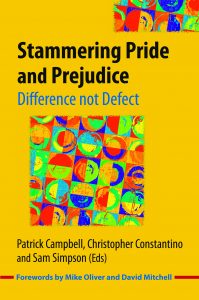
Wanting some Christmas shopping inspiration? We thought we’d gather together a few early reflections on Stammering Pride and Prejudice to give people a taste for the book, and hopefully encourage one or two to buy it for themselves or a loved one this Christmas.
In the UK and rest of Europe, the book is available from http://www.jr-press.co.uk/stammering-pride-prejudice.html.
In the USA, it is available at https://www.stutteringtherapyresources.com/books/menu-stammering-pride.
We hope these reviews are just the beginning: we invite others to write in or tweet with reflections and thoughts on the book. Here’s hoping for an exciting 2020 filled with rich and thick stammering narratives:
‘Despite having a close relative who stammers, I am ashamed to say that prior to reading Stammering Pride and Prejudice I had not previously thought much about what it is like to stammer. Fluent privilege, it turns out, is not thinking twice about a voice-activated phone system – and even less about the societal stigma that exists around differing forms of speech. Stammering Pride and Prejudice changed this. Through an engaging collection of personal reflections, essays and art, this book broke down many of my misconceptions around stammering. It also introduces the concept of the social model of disability in an accessible and thought-provoking way. The book highlights how social stigma and inaccessible systems are in themselves disabling, while also offering practical solutions as to how we can create a society which supports and encourages different ways of speaking. Told with warmth, humour and creativity, the individual stories and perspectives communicated by the book offer a rich insight into a community working to breakdown stigma and celebrate diversity. Whether you stammer or not, this book is an important and extremely worthwhile read.’
Kristine Cimals, daughter of a person who stammers
‘Stammering Pride and Prejudice: Difference not Defect comes at a time when people who stammer are learning more about the idea of owning their dysfluency with pride. The book offers multiple viewpoints from all kinds of people who stammer — speech language pathologists, poets, comedians, professors, amongst many others — who altogether prove that dysfluency is ‘rich with meaning in its own right’ (from contributor Emma Alpern).’
Conor Foran, Graphic Designer and person who stammers
‘I will recommend this book to each person I work with on stammering, because I think it has the power to do more good than I can. Why? Because its power comes from lived experience, from authenticity I can only parrot in clinic sessions, which is written and stammered far more clearly and beautifully than I can summarise.
Interactions with stammering pride, Patrick, City Lit and the contributors to this book have profoundly shaped my understanding of and practice in stammering. It feels as though it has, applying some of Katy’s words, began ‘retraining’ me as a speech and language therapist. People who stammer, I’ll lend you my copy. Everybody else, buy your own!’
Annabel Kay, Speech and language therapist and lecturer at the University of Essex
‘This is a book that’s been long in the making. I have to admit I had been waiting for its publication with a mixture of anticipation and trepidation. I am not a dogmatist. I would like to think I am generally quite good at seeing other people’s points of view and as someone, at the time, whose main job was to hold the diverse stammering community in the UK together I was a little worried. Especially as I had been so upset by the first Stammering Pride and Prejudice event at City Lit some years back and nearly walked out at the time.
So when it arrived, I started to read with my blood pressure tablets at hand…
I needn’t have worried. Stammering Pride and Prejudice offers a different (and sometimes radically different) point of view. But the thoughtfulness of its editors ensures that it remains an offer, an invitation, to think about things slightly differently.
What if stammering is merely a different view of speaking, just as Autism Spectrum Disorder is a different way of perceiving the world? And what would a world that believed this look like? It is a challenge and an interesting thought experiment – though posed by many whose stammer is perhaps less of an overt struggle than it can be for some. But, however severe your stammer, I believe that learning the confidence to say “this is how I speak” can only be beneficial.
Even if you violently disagree with the book’s premise, I’d urge you to read it for the many passages that so beautifully capture the experience of stammering, such as ”Stuttering cannot be heard by the listener. It is not a sound”.
I also really enjoyed being asked to think about what my personal stammering gains might be – something that only stammering can and has given me: “When I stutter I am watching with curiosity how my listener reacts… Stuttering may give us special insight into language by breaking it open and exposing its seams”.
I’d really recommend this book to anyone affected by stammering – it may or may not turn you into a disability activist, but it can help you be more at ease, more at peace with that ‘glitch’ that makes our way of communicating different.’
Norbert Lieckfeldt, person who stammers, Corporate Governance Manager at East London NHS Foundation Trust and former CEO of the British Stammering Association